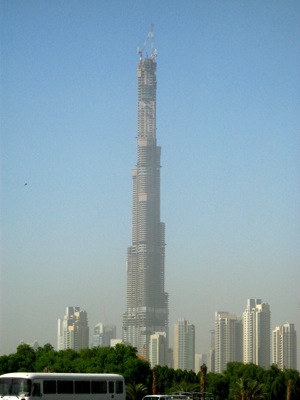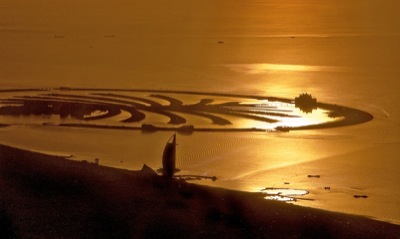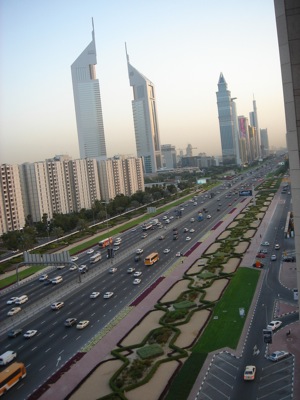Someone sent me an email last week about “craziness,” that is, rapid growth and development, in Dubai, a city (and emerite, or what we would call a state) in the United Arab Emerites. Dubai has been doubling in population every decade and construction in the city has been phenomenal.
The Burj Dubai, soon to be the world’s tallest building.
Flickr photo by Pete the Painter.
Dubai features some of the world’s tallest buildings, dozens of artificial islands, the world’s largest artificial port, an indoor ski resort, and the world’s most luxurious hotel. Developments planned or under construction include the world’s largest amusement park, the world’s first undersea hotel, and a building that is expected to be 40 percent taller than what is now the world’s tallest skyscraper. Its airport, which currently moves as many people as the one in the Twin Cities and as much cargo as Chicago O’Hare, is expected to eventually be the biggest in the world.
The email I received included six photos of Dubai today or in the recent past and 20 artists’ conceptions of what it would be like in a few years. Looking around the web for the source of the photos, I found they had recently been posted on numerous blogs, many with the same or slightly altered text from the email I received.
The original posting seems to have been here, but don’t bother clicking (unless you want to join and read the forum comments) because all of the photos are gone. The most complete posting, with all photos and text (including swear words deleted from the email I received) is here. The first posting is dated December, 2006. I suspect someone downloaded the second posting a few weeks ago, turned it into an email, and sent it around the Internet. Others then posted it on their blogs.
The Palm Islands, designed to provide the maximum amount of waterfront property. The 1,050-foot-tall Burj Al Arab Hotel is in the foreground.
Flickr photo by Michael Foley.
Many of the blogs say things like, “here is where all your gasoline money is going.” But that isn’t really true. Dubai’s oil revenues have been declining for decades, and its government made the decision years ago to transition to manufacturing and trade. More recently, it decided to promote itself as a tourist destination. Today, oil contributes only 6 percent to its gross domestic product, and that is declining.
Oil money provided a catalyst, but what really made Dubai grow is freedom — freedom from taxes, tariffs, and regulation. While Dubai is not entire tax free, it has established a number of tax-free zones in which all businesses are exempt from taxes for 15 years (or 50 years in some zones) — renewable on application for an indefinite number of additional 15- (or 50-) year periods. Dubai has no personal income or property taxes, no import or export tariffs, and its land-use regulations are minimal. While the government pays for infrastructure, such as subway and monorail systems now under construction, I suspect it expects to recover much of these costs in user fees.
One place where Dubai could use a little regulation is in worker rights. Roughly 80 percent of the population is foreign workers, mostly from India, Pakistan, Bangladesh, and the Philippines. When developers run low on funds, they apparently have no hesitation in keeping their workers on the job for weeks or months without pay. Workers who quit can expect to lose all the pay they are owed. Workers who protest can expect to be deported. Dubai could probably fix these problems without significantly reducing its growth.
Aside from this, Dubai shows how the Muslim world can peacefully co-exist with the West. Residents enjoy freedom of religion. Although proselytizing is not allowed, members of any religion can get government land grants to build their own houses of worship. Many of the investors in Dubai are Israeli.
The Antiplanner is not really attracted to living in cities — the more exurban the better — but I looked up some prices out of curiosity. A room at the Burj al Arab Hotel starts at $1,500 a night. A villa in the Palm Islands goes for about $2.5 million — they all seem to be a modest 7,000 square feet in size. I was able to find one-bedroom condos for under $100,000 and two-bedroom townhouses for around $250,000.
The Dubai Strip in 2005. See here for 1990 and 2003 views of the same street.
Flickr photo by pbo31.
The closest thing to Dubai in the U.S. is Las Vegas. Both are doubling in population about every ten years. Both can credit that growth to minimal land-use regulation and resulting low construction costs. Both are seeing outlandish building designs aimed at attracting tourists. Dubai is a little more outlandish, possibly because of the subsidized architecture (Henry Petroski says in one of his books about engineering that any high rise above about 80 stories has to be subsidized — the added structural cost can’t be justified by the rents on the extra floor space).
I am sure some New Urbanist will say, “Dubai proves that people want to live in denser cities.” But the 3 percent of Dubai residents considered “Westerners,” i.e., Europeans and Americans, mostly live in the waterfront villas and other low-density buildings. Many of the 17 percent of residents who are citizens of Dubai probably also live in low-density areas. While some of the high density is for the wealthy elite, most is for the guest workers whose preferences are not given much consideration.
What Dubai really proves is that cities can grow and be attractive without a lot of government planning. While some may argue over whether infrastructure subsidies or freedom from regulation played a bigger role in Dubai’s growth, few could argue that Dubai would benefit from plans “drawn with such precision that only the architectural detail is left to future designers,” as some planners would like to see here in the U.S.











“I am sure some New Urbanist will say, “Dubai proves that people want to live in denser cities.†But the 3 percent of Dubai residents considered “Westerners,†i.e., Europeans and Americans, mostly live in the waterfront villas and other low-density buildings. Many of the 17 percent of residents who are citizens of Dubai probably also live in low-density areas.”
I was in Dubai this summer and I can tell you that there is NO low density waterfront developments. If fact there is almost no low density development in Dubai at all. Don’t believe me. Google map it and look at the footprint of the city. Not much land coverage for such a big city. A.P. sometimes you amaze me with your seemingly factless reporting (oh I’m sorry… blogging).
Also there is a lot of planning that goes on in Dubai. Yes it is very different then the American version of planning, but to think that what is going on over there can happen without any unified vision from the government and their planners is stupid!
Randal, now you’re disappointing me! And I thought you were a worthy opponent who had a fairly strong grasp of the facts…
Dubai is being created by the ultimate planning system: the dictates of one man, the Emir. Yes, he’s smart enough to state what he wants, and then lets the various foreign capitalists run free to get what he asks for actually accomplished. As you correctly noted, this is too often based too semi-slave labor of non-Arabs who live in often appalling conditions off in the desert, certainly not near the Dubai waterfront.
Under these conditions, there is no way that Dubai can be considered even close to a “free market nirvana,” in light of the Emir’s so far benign, but still dictatorial powers, let alone the hundreds of billions of “sovereign (sic) fund” accounts that he controls.
Also, Dubai is no more “ultra capitalist” than the guided capitalism of Malaysia, Singapore, Hong Kong, and the other so-called economic “Asian Tigers.” You may not have noticed but these “economic miracles” have had systems of very high tariffs and heavy government investment and direction of infrastructure development, much as England and the U.S. had during the go-go days of the Industrial Revolution in the late 18th, 19th and early 20th Centuries.
I am sure some New Urbanist will say, “Dubai proves that people want to live in denser cities.â€Â
Dubai doesn’t look like anything new urbanists would herald.
Is Dubai the first city built by the decree of a monarch since St. Petersburg?
Fro those fascinated by skyscrapers or urban dynamics, launch Timeformations is a must visit.